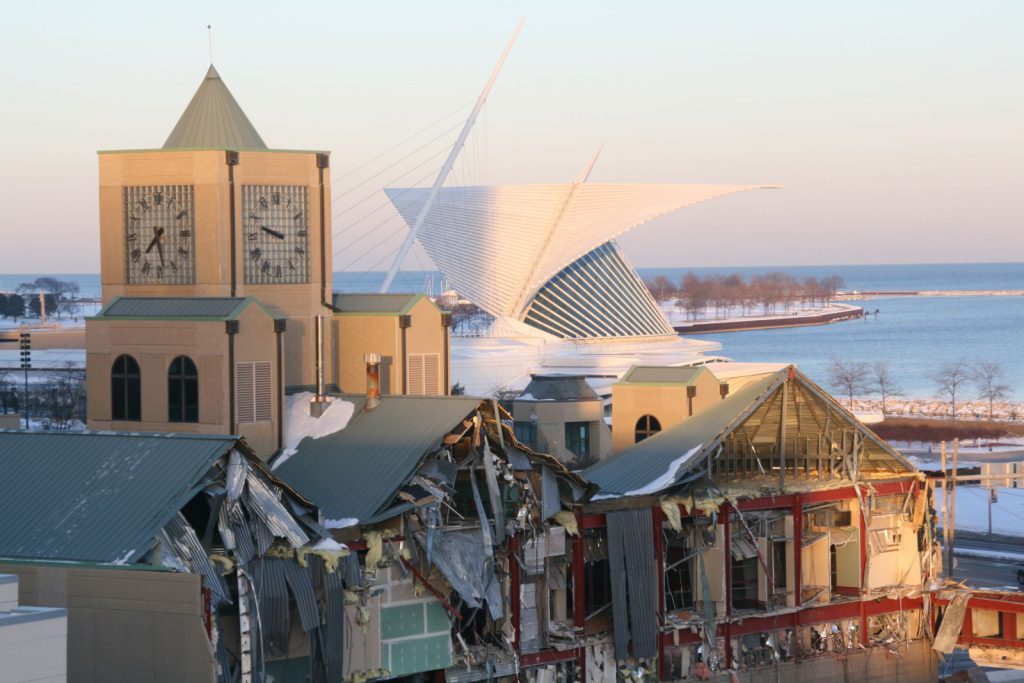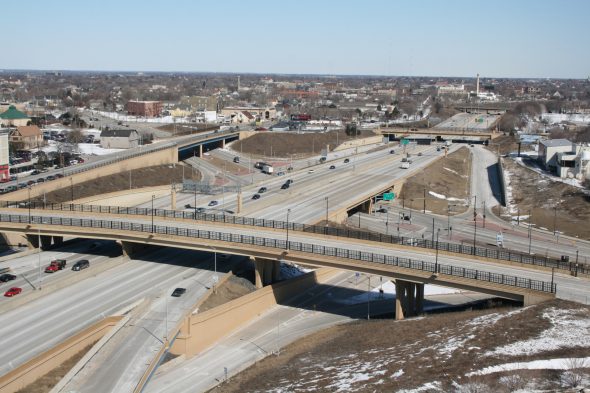How Federal Funding Hurts Cities
Liberals and cities would be better off opposing funding.
The surprise election of Donald Trump has mayors and other local officials worried, especially after Trump’s appointment of Dr. Ben Carson, a man with no experience and little interest in local government, as Secretary of the US Department of Housing and Urban Development. Judging by commentary in liberal media the end is nigh. Cities could lose everything, except…. cities actually don’t have much to lose. Looking at a database constructed by the Lincoln Institute of Land Policy, you’ll see the median percentage of direct government expenditures of the 150 largest cities (adjusted to amalgamate and measure all local services whether delivered by municipality, county, school system or special district) is just 5.5 percent federally funded.
This runs counter to the image often projected by liberals and conservatives alike that federal subsidies to cities provide a large portion of local government revenue. Some of the cities with a reputation for needing and seeking federal subsidy receive less than the median. Detroit receives 4.8 percent of its expenditures from Federal sources and Buffalo 4.3 percent. Milwaukee is at a measly 2.9 percent. Local governments and their lobbying associations have been remarkably unsuccessful at obtaining dollars from the national government. They won a victory in 1972 when President Richard Nixon signed Federal Revenue Sharing into law. It provided no-strings-attached dollars to municipal budgets. Most cities shared in these transfer payments and poor small towns in rural states were among the greatest beneficiaries. But after some small cuts by Presidents Gerald Ford and then Jimmy Carter in this program, the coup-de-grâce was delivered by President Ronald Reagan when in 1986 Federal Revenue Sharing was repealed. In the competition for a share of the federal pie, cities just couldn’t compete with more powerful interests such as military equipment makers or the farm lobby and its cherished crop subsidy program.
In the book, What’s the Matter with Kansas?, Thomas Frank wondered why poor and middle class citizens in rural GOP states voted Republican and supported the GOP’s stance against federal spending even though their states disproportionately benefit from these transfer programs. Good question, but why not also ask liberals in big urban states like California and New York why they cheerfully pay way more in federal taxes than they get back in benefits? And that’s the thing: those who say they want to shrink the federal government benefit from more funding and those who support it tend to lose.
I find liberal enthusiasm for federal spending even stranger considering that some programs, particularly those that fund infrastructure and housing, actually can reduce the value of cities. From postal service to electrification and now possibly high speed internet service, urban taxpayers have been forced by the national government to subsidize rural services. Almost every little remote village has its own post office while over the last 30 years neighborhood post offices have been closed and consolidated and this at a time when private sector package deliverers like Amazon, UPS and Fedex are opening urban neighborhood service centers. The Rural Electrification program extends subsidized electricity to remote areas, undermining the natural advantage that proximity and density give to cities. There are efforts generated in both parties to promote the same for high-speed internet service.
The Federal Housing Administration has, since its creation in 1934, encouraged low-density housing and has assigned extra risk to housing proposed to be in close proximity to retail. These FHA rules on mortgage lending have migrated to the quasi-government agencies Fannie Mae and Freddie Mac and even into privately financed mortgage lending. HUD’s huge 221d4 multi-family program guarantees loans to developers, but only if they conform to rules that reinforce separate use zoning. One rule requires that 221d4 buildings must contain no more than 10 percent non residential. This means a building with retail on the first floor would have be 10 stories tall. This is not a problem in midtown Manhattan, but it’s a huge obstacle to street level retail in mid-sized cities across America. It’s even a problem in Brooklyn. For example, Flatbush Avenue is lined with many two to five story buildings built before FHA was founded in 1934. Many have apartments on the upper floors, but because of the 10 percent rule the apartments aren’t eligible for 221d4 nor do they qualify for FHA condo mortgages. In the last decade the market demand for urban living in walkable mixed-use urban neighborhoods has grown even while the federal government regulates against it.
The federal government’s transportation programs enable and favor long commutes over short trips involving walking, bicycling or transit. Federally funded projects tend to be gargantuan, serving travel over long distances: expressways and airports rather than the networks of streets and sidewalks that serve as the setting for commerce and the vitality of cities. Traditionally in the history of civilization, urban thoroughfares served three functions: (1) movement of goods and people; (2) a setting for commerce — the marketplace; and (3) a place for social interaction. Federal and state governments understand and embrace the first purpose, but largely ignore the second and third. There is a superficial logic to this thinking as the states are bigger in area than cities and the U.S. is vastly larger than any one state. However, if measured by economic value added, the dense and complex streets and transit networks of cities yield more return on investment. Urban economies also deliver most tax revenue to states and the federal government. This is especially the case when you comparison the imposition of rural road types like expressways to the traditional urban fabric.
To the federal government, and to most states as well, long-distance commutes by car are deemed appropriate for lavish subsidy while movement by walking, bicycle or transit are afterthoughts. Say there are two people doing the same job at the same business. One lives 20 miles away and drives on an expressway for most of her trip. The other lives across the street and walks to the workplace.Which one adds the most value? Actually both add the same value. However the 40-mile, round-trip auto commuter benefits from taxpayer financed roads while her vehicle issues pollutants. The pedestrian worker requires no infrastructure other than a sidewalk and issues no measurable pollution as she strolls out her door and crosses the street to her job. So the costs are lower with the walking commute while the benefits are equal.
In the 1960s the Wisconsin DOT sought to acquire land and build a vast Milwaukee expressway system. Before that, in 1949, the City of Milwaukee actually built a two- mile expressway with its own money. It ran through the city’s most popular park, ruining it, and divided the adjacent neighborhood. From a property tax base standpoint, it was a disaster. The city probably would have never built another one, but the state, having been showered with Federal Interstate money, reopened the issue. Freeways were built until the late 1970s, when neighborhood resistance grew. Opponents recruited candidates against road supporting legislators and defeated them. Similar road resistance movements broke out in New York, Boston, Cleveland and Washington D.C.
Recently James Fallows, editor of the Atlantic magazine made the point that local government is far more trusted to make wise decisions than the national government:
Are these impressions incomplete and anecdotal? Of course. But systematic surveys show the same thing. A Pew study in 2014 found that only 25 percent of respondents were satisfied with the direction of national policy, but 60 percent were satisfied with events in their own communities. According to a Heartland Monitor report in 2016, two in three Americans said that good ideas for dealing with national social and economic challenges were coming from their towns. Fewer than one in three felt that good ideas were coming from national institutions. These results also underscore the sense my wife and I took unmistakably from our visits: that city by city, and at the level of politics where people’s judgments are based on direct observation rather than media-fueled fear, Americans still trust democratic processes and observe long-respected norms.
Richard Florida, author of The Rise of the Creative Class, recently argued for devolution of power to cities to put the government and public policy more in sync with today’s economy. Florida describes the economy as dominated by urban concentrations of knowledge instead of resource extraction and manufacturing. He points to the November election backlash of the rural and less educated as evidence of this disconnect. Florida, however, offers no details on how to devolve power to cities.
In my view it would first require cities to advocate a more limited role for the national government. For advocacy organizations like the US Conference of Mayors, the National League of Cities and National Association of County Officials, this would mean abandoning their near hopeless dream of significant transfer payments from the federal treasury and instead oppose spending of urban taxpayers’ money on transfers to rural and wasteful national and state government interests. To achieve more power and control at the local level urban lobby groups would, in effect, switch sides and oppose more federal spending. This would present a difficult transition in thought for municipal officials, but it might be more effective than their long and unsuccessful effort to become more dependent on federal spending.
John Norquist served as Mayor of Milwaukee from 1988 to 2004.
























Norquist writes “…in 1949, the City of Milwaukee actually built a two- mile expressway with its own money. It ran through the city’s most popular park, ruining it, and divided the adjacent neighborhood.”
Does anybody know which freeway and which park?
The only thing I can think of would be today’s Highway 175 (fka US 41) which forced the zoo to relocate from Washington Park to Bluemound Road, but that construction happened well after 1949. I was born in 1951 and remember the Washington Park Zoo, so I know that freeway went in well after 1949.
Norquist states,”Good question, but why not also ask liberals in big urban states like California and New York why they cheerfully pay way more in federal taxes than they get back in benefits?”
— Mr. Norquist, last I saw Republican’s are attempting to due away with loop holes such as writing off state property taxes. If blue states pay so much more in state taxes than red states why do Democrats in blue states want to protect the rich with lavish loopholes in big government states such as New York and California. Why do you protect the mortgage deduction another loop hole that benefits the well to do. ARE YOU NOT THE PARTY THAT PROTECTS THE POOR?
@TomD perhaps he’s referring to Borchert Field?
I too cannot figure out which freeway was built in 1949 that ruined a park. Have heard negative comments about today’s WI-175 north of the Stadium and how it cut part of the side off of Washington Park, but also pretty sure that was after 1949.
Maybe it was planned in 1949 but built later…References:
http://www.wisconsinhighways.org/milwaukee/index.html
http://www.wisconsinhighways.org/milwaukee/system_map_1949.html
(the link to the map shows what is today’s WI-175 on the far left edge)
I believe that Norquist is slightly jumbling the history. He is mixing up the later freeway construction that sliced off a part of Olmstead’s Washington Park, with a connector to that freeway. Same freeway but what sliced off the park was an extension of the original works.
http://www.wisconsinhighways.org/milwaukee/index.html
“Construction quickly commenced and in 1953, the first 2,200 feet of freeway was completed in the South 43rd St corridor northerly from STH-59/National Ave to Wells St.”
Jason, go troll elsewhere. If red states cared about low taxes, they wouldn’t tax the poor… instead they let the rich pay nothing and the middle class has to make up the difference.
Borchert Field wasn’t torn down until 1953, the first year the Braves played in County Stadium.
@Jason – I’m picturing you delivering your unhinged little rant like a shirtless, red-faced Alex Jones. WE’RE GONNA BRING THESE CROOKS TO JUSTICE!!!!!!
Did Norquist ever finish paying off Marilyn Figueroa the $375K for his sexual harassment case? How can anything he has to say be taken seriously?
Bob, that’s a good question. Maybe the world of the present doesn’t care about the past, even what someone has done a few years, months, or days ago doesn’t matter.
See President Trump.
When will Democrats ask for the hedge fund guys to pay their fair share? They pay less in federal taxes than a public school teacher per $1.00 of income. The blue states of the North east must be protected from the rest of us. I can see why billionaire’s Buffett, Gates, and Jeff Bezos call the Democrats home. The Democrats protect the rich. The Billionaire’s own the NY Times and the Washing post and they do your bidding. Working class Democrats are gone with the dinosaurs.
I should have identified the expressway. The Stadium North was authorized in 1949 and opened to traffic in 1953. Thank you Tim for the link.
Mr. Norquist, I will give you Kudos for some of the vision for downtown. Whether it was you or Barry Mandel knocking down that freeway strip that ran through downtown was badly needed. Potawatomi placement had its critics but you proved them wrong.
I lived on the Lower East Side before, during, and after John Norquist was mayor, and am completely satisfied that he was the best mayor Milwaukee has had in generations.
Mr. Norquist understands the function of cities, and the services which city governments must deliver in order to attract and hold the middle and upper income groups. Without good public schools, safe streets, competitive taxes and regulations, ease of transportation -most certainly including neighborhoods as walkable at the Lower East Side- and an end to federal subsidies for those who want to flee cities, cities are and should be doomed. Most of the problems Milwaukee and other cities have in delivering the goods can be traced at least in part to federal policies and subsidies -as Mr. Norquist touched on above. For far more depth, you should read his book, ‘The Wealth Of Cities’. Available at Amazon.
Is he a perfect man? Hardly, He was only the best Milwaukee mayor of my lifetime.
Norquiest was a good Mayor, better than any of them. Realized that unless MIlwukee had good schools the city would fail an it is failing.
Good downtown, East side where the big money lives but Inner City a zoo of murder, car Jacking, crime, heroin, human trafficking, bad roads etc. I would vote for John again.
Jonny B Norq, our former rock ‘n roll mayor, had a vision for downtown that has blossomed. It is sad that his career as mayor ended in a scandal. He apparently thought that being tall and powerful made him irresistible to a short and beautiful woman who apparently was not impressed by his height or power. More scandalous than Jonny’s truncated career as our mayor was the way he and his people treated the victim of his unwanted affection.
As hip as rockin’ Jonny was to the potential of downtown, he was tone deaf to our inner city; moreover, he let the northwest side deteriorate into ghetto sprawl. That said, I say that Norquist was a good mayor, but not a great mayor. I have to go back to the late, great Frank Zeidler (mayor from 1948 – 1960) to find a great mayor of Milwaukee.
Mr. Norquist, I will give you Kudos for some of the vision for downtown. Whether it was you or Barry Mandel knocking down that freeway strip that ran through downtown was badly needed. Potawatomi placement had its critics but you proved them wrong.